

Twitter. Twitter. Pedestal / Plinth Project. ASU Professor Urges Reflection On Southwest Colonial History. Vanessa Fonseca-Chavez VANESSA FONSECA-CHÁVEZ: Most people know him as the last conquistador, not because they love naming him that, but because he was the last Spanish conqueror to enter this area.

So you have this individual who essentially for many people, is known as the founding father of New Mexico — the founding Spanish father of New Mexico. And of course, that's a really problematic way to look at him. But there are many folks in New Mexico, Hispanics, who can trace their lineage back to some of those primary expeditions into New Mexico and those. Casting A Monument To Louis XV. KCRW sur Twitter : "In 1969, a bronze sculpture called the Well of Scribes went missing from the @LAPublicLibrary. It was never seen again — until now. Part of the sculpture resurfaced in Arizona. Listen to find out how a pretty large sculpture just disap. Why those Confederate soldier statues look a lot like their Union counterparts. President Trump’s supportive comments about Confederate monuments have focused new attention on long-ignored Civil War statues of a mustachioed infantryman standing at rest, wearing a greatcoat and holding a rifle barrel.
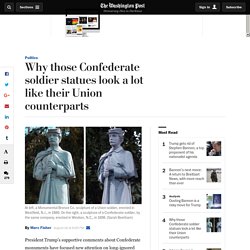
The nameless figure, known to many as the Silent Sentinel, gazes over town squares and courthouse steps in dozens of Southern towns — but not just there. Many of the South’s Silent Sentinels turn out to be identical to the statues of Union soldiers that decorate hundreds of public spaces across the North. Identical, but for one detail: On the soldier’s belt buckle, the “U.S.” is replaced by a “C.S.” for “Confederate States.” It turns out that a campaign in the late 19th century to memorialize the Civil War by erecting monuments was not only an attempt to honor Southern soldiers or white supremacy.
It took some years before Southern customers caught on and sought to buy statues of soldiers who were more obviously Grays rather than Blues. “This wasn’t true,” Beetham said. Set in Stone? Statues and Slavery in London. We use cookies to enhance your experience on our website.By continuing to use our website, you are agreeing to our use of cookies.

You can change your cookie settings at any time. <a href=" Find out more</a> Skip to Main Content Search Close Advanced Search Search Menu Article Navigation Volume 64 Issue 1 Autumn 2007 Article Contents. Blog post by Mary Beard - The TLS. The Romans had many ways of dealing with the statues of those they no longer wanted to honour.
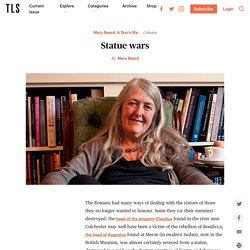
Some they (or their enemies) destroyed: the head of the emperor Claudius found in the river near Colchester may well have been a victim of the rebellion of Boudicca; the head of Augustus found at Meroe (in modern Sudan), now in the British Museum, was almost certainly severed from a statue, destroyed in a raid on the Roman province of Egypt; and there are any number of references in ancient writers to the statues of the short-lived would-be emperors in the civil wars of 68–69 CE being thrown away, just as soon as another very temporary new emperor arrived on the scene.
But the Romans were much more imaginative than that. ‘There is a lot of hard work to be done’: How the art world can step up for Black Lives Matter. The Independent employs over 100 journalists around the world to bring you news you can trust.
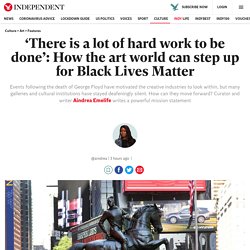
Please consider a contribution or subscription. Dear art world, we have a problem. In the days after the death of George Floyd, my Instagram feed began to fill with images that were different to the usual fluffy skirts of Monet or Koons’s jewel-tone balloon dogs, posted by art-world chums. They were replaced with frequent appearances of powerful artworks by black artists: David Hammons’s African-American Flag or Glenn Ligon’s neon light spelling “America”. But curiously, these images seemed not to be coming from the institutions where these artworks are held. The resurgence of Black Lives Matter is inspiring many industries to look within and do better.
Download the new Independent Premium app Sharing the full story, not just the headlines Some settled for Martin Luther King quotes. Perhaps the art world thinks it’s enough that visibility for black artists is incrementally increasing. Questions? Museum world rallies behind curator investigated for tweets on how to damage bronze statues. Curator Madeline Odent's tweets attracted criticism for including an image of a Winston Churchill statue in London's Parliament Square that was defaced during Black Lives Matter protests last weekend Photo: PA/Alamy UK arts professionals are voicing support for Madeline Odent, a curator at the Royston and District Museum and Art Gallery in Hertfordshire, who sparked controversy after discussing on social media substances that could be used to damage bronze statues.
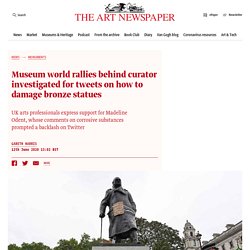
Odent posted a series of tweets to her personal account after Black Lives Matter demonstrators toppled a statue of slave trader Edward Colston in Bristol and historic statues worldwide come under scrutiny. Odent wrote on Twitter: “From an art conservation perspective, it’s honestly fine to throw paint on memorials of genocidal racists! Paint is pretty easy to clean off. What would be an absolute shame is if people were to throw certain common household items that can cause irreversible bronze disease.” 21st cen "monuments" Reconsidering the Past, One Statue at a Time.
At least 114 Confederate symbols were removed in the years after a white supremacist killed nine people at a historic African-American church in Charleston, S.C., in 2015, according to a 2019 report by the Southern Poverty Law Center.
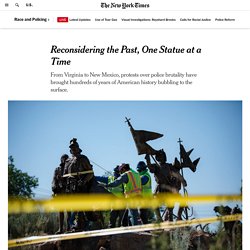
The killing of Mr. Floyd in Minneapolis re-energized that movement, as demonstrators chipped away at a 52-foot Confederate obelisk in Birmingham, Ala., and toppled a statue of Jefferson Davis, the president of the Confederacy, in Richmond, Va.